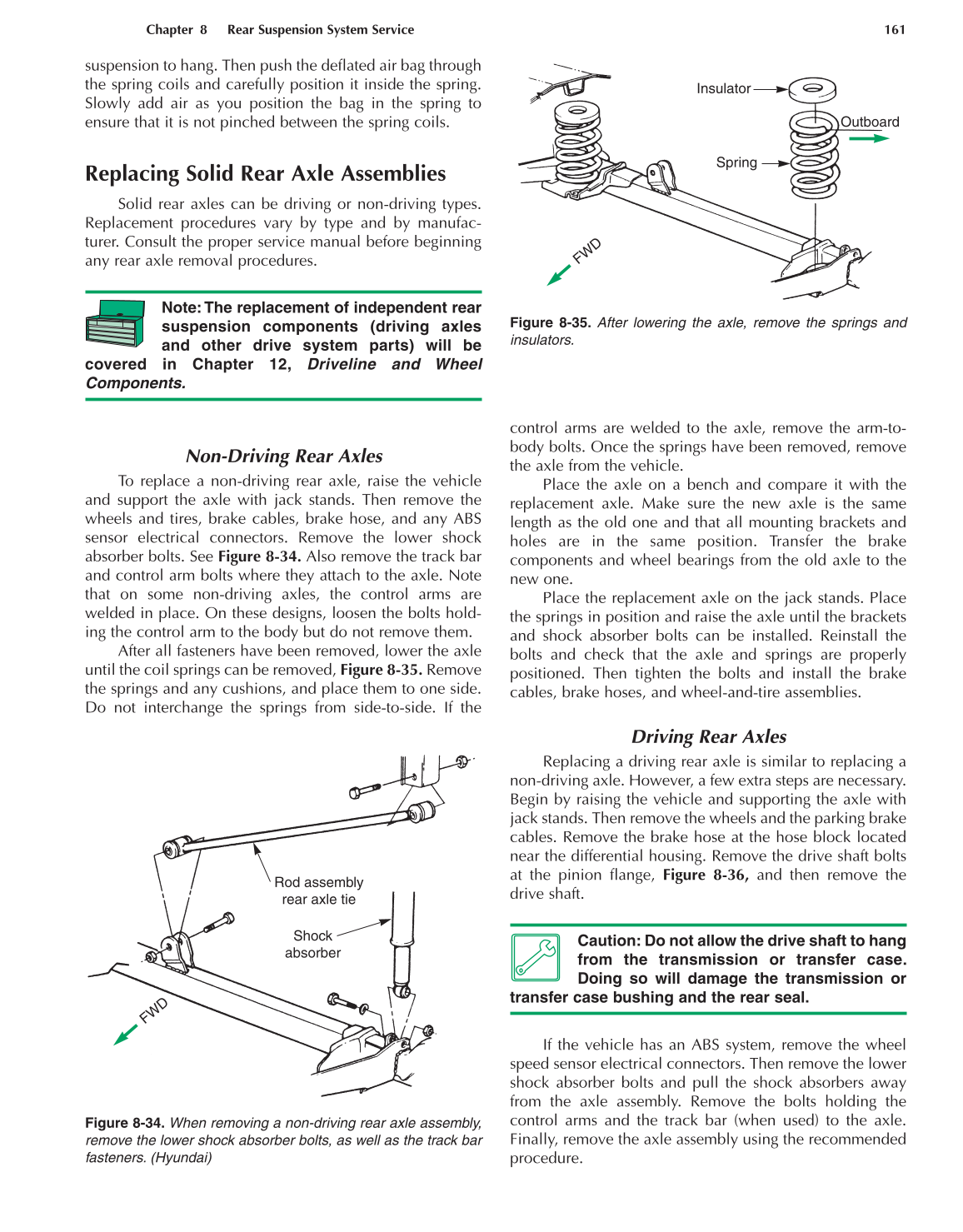Chapter 8 Rear Suspension System Service 161
suspension to hang. Then push the deflated air bag through
the spring coils and carefully position it inside the spring.
Slowly add air as you position the bag in the spring to
ensure that it is not pinched between the spring coils.
Replacing Solid Rear Axle Assemblies
Solid rear axles can be driving or non-driving types.
Replacement procedures vary by type and by manufac-
turer. Consult the proper service manual before beginning
any rear axle removal procedures.
Note: The replacement of independent rear
suspension components (driving axles
and other drive system parts) will be
covered in Chapter 12, Driveline and Wheel
Components.
Non-Driving Rear Axles
To replace a non-driving rear axle, raise the vehicle
and support the axle with jack stands. Then remove the
wheels and tires, brake cables, brake hose, and any ABS
sensor electrical connectors. Remove the lower shock
absorber bolts. See Figure 8-34. Also remove the track bar
and control arm bolts where they attach to the axle. Note
that on some non-driving axles, the control arms are
welded in place. On these designs, loosen the bolts hold-
ing the control arm to the body but do not remove them.
After all fasteners have been removed, lower the axle
until the coil springs can be removed, Figure 8-35. Remove
the springs and any cushions, and place them to one side.
Do not interchange the springs from side-to-side. If the
control arms are welded to the axle, remove the arm-to-
body bolts. Once the springs have been removed, remove
the axle from the vehicle.
Place the axle on a bench and compare it with the
replacement axle. Make sure the new axle is the same
length as the old one and that all mounting brackets and
holes are in the same position. Transfer the brake
components and wheel bearings from the old axle to the
new one.
Place the replacement axle on the jack stands. Place
the springs in position and raise the axle until the brackets
and shock absorber bolts can be installed. Reinstall the
bolts and check that the axle and springs are properly
positioned. Then tighten the bolts and install the brake
cables, brake hoses, and wheel-and-tire assemblies.
Driving Rear Axles
Replacing a driving rear axle is similar to replacing a
non-driving axle. However, a few extra steps are necessary.
Begin by raising the vehicle and supporting the axle with
jack stands. Then remove the wheels and the parking brake
cables. Remove the brake hose at the hose block located
near the differential housing. Remove the drive shaft bolts
at the pinion flange, Figure 8-36, and then remove the
drive shaft.
Caution: Do not allow the drive shaft to hang
from the transmission or transfer case.
Doing so will damage the transmission or
transfer case bushing and the rear seal.
If the vehicle has an ABS system, remove the wheel
speed sensor electrical connectors. Then remove the lower
shock absorber bolts and pull the shock absorbers away
from the axle assembly. Remove the bolts holding the
control arms and the track bar (when used) to the axle.
Finally, remove the axle assembly using the recommended
procedure.
Rod assembly
rear axle tie
Shock
absorber
FWD
Figure 8-34. When removing a non-driving rear axle assembly,
remove the lower shock absorber bolts, as well as the track bar
fasteners. (Hyundai)
Outboard
Spring
Insulator
FWD
Figure 8-35. After lowering the axle, remove the springs and
insulators.
